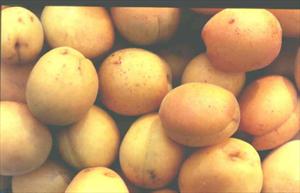Mormon Apricots

Clive Simms, author of The Nutshell Guides to growing fruit, tells us about an apricot that crops well in Lincolnshire, north east England.
Apricots are said not to be good croppers in southern England, let alone as far north as Lincolnshire, but one of the trees that I have grown from a packet of stones is proving the old assumptions wrong. Last year was the first time my tree cropped properly. The previous year there were a handful of fruits but the birds took most of them. In 2006, admittedly a good year for apricots, we harvested 44 lbs of excellent fruit - intensely flavoured, quite sharp and making superb jam. What I also find particularly notable is that the tree is growing completely exposed to the elements in the middle of a large agricultural field, no warm south facing wall here!
The story of this tree begins in 1990 when I bought a handful of seeds from an American who was offering them in one of the newsletters to which I subscribe. The man who sent me the apricot seeds lived in Arizona, USA, on top of a high plateau that has a harsh climate and is not a good area for growing fruit (USDA zone 5, elevation 5,725 feet). His father had tried numerous named selections of apricot but all cropped poorly and erratically due to the frequent spring frosts at blossom time. Many trees simply gave up and died. However, there are many seedling apricot trees in the area that were brought there by Mormon settlers in the late 1880s. Some of these trees are large, up to 50 feet tall, and crop far more regularly than the varieties offered commercially. The fruit is relatively small but very tasty and collected by the locals to use for preserves.
By way of comparison with nursery bought apricots he said that his father’s two 16 year old Wilson apricot trees have produced a total of six crops, whereas his brother’s Mormon seedling has had crops 13 out of the same 16 years. Tilton and Moorpark had done somewhat better for him (two out of five years) but did not come anywhere close to the performance of the Mormon seedlings.
Intrigued about the origins of this apricot I asked the opinion of a knowledgeable American friend. He said that Mormon apricots were good for difficult areas of the USA and were possibly introduced from Asia, being sometimes referred to as Chinese Mormon apricots.
It will be interesting to see how my tree crops in the future, and it may be that the success of 2006 will never be repeated. However, I am optimistic that this will not be the case. As compared to the other trees in my apricot collection this one stands out as particularly healthy and robust with very little signs of gumming or die-back. Perhaps the fact that it is on its own roots and not grafted has something to do with it, I do not know. What I do know is that taking the time and trouble to grow a fruit tree from seed is fascinating and may just possibly result in something better than was available before.
To comment on this article please visit our blog.
